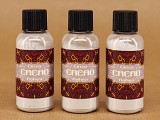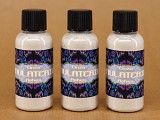Bottle, 10 Ml, 7 Gr from Brazil (SKU 4946)
Bashawa Niure ashes from the Calophyllum brasiliense tree bring powerful grounding and spiritual cleansing to Rapé. Valued by Amazonian tribes, especially the Kaxinawa, these ashes help clear negative energy, support emotional stability, and enhance focus during rituals. When used in Rapé blends, Bashawa Niure ashes foster a profound connection to the earth and align spiritual energies. Ideal for those seeking deep meditation and balance, this ash is an essential addition to transformative practices. More information can be found below.
Packed in 10 ml clear plastic bottles containing 7 gr.
| change currency | |||||||||
| SKU | Part | Volume | Weight | Unit | Price | Qty
|
|||
|---|---|---|---|---|---|---|---|---|---|
| 4946 | bottle | 10 ml | 7 gr | 1 pc | $ 6.93 | ||||
| 4947 | bottle | 25 ml | 15 gr | 1 pc | $ 14.55 | ||||
| 4948 | pot | 60 ml | 40 gr | 1 pc | $ 27.71 | ||||
Bashawa Niure Ashes: Grounding and Spiritual Clarity in Rapé
Overview
Bashawa Niure ashes, derived from the Calophyllum brasiliense tree, hold a central role in Amazonian Rapé blends due to their grounding, cleansing, and spiritually balancing effects. Often referred to as the "Tamanu tree," Bashawa Niure provides ashes prized for their stabilizing energy, making them a key ingredient for those seeking emotional release, clarity, and alignment during spiritual practices. These ashes promote a sense of deep connection to the earth, which can enhance grounding and spiritual depth.
Cultural and Spiritual Significance
In Amazonian tradition, Bashawa Niure is highly regarded for its powerful grounding properties. The ashes are commonly used by indigenous groups, such as the Huni Kuin, during rituals aimed at spiritual cleansing and energy balancing. When added to Rapé blends, Bashawa Niure ashes support emotional stability and help practitioners maintain clarity and focus, making them ideal for ceremonies where spiritual protection and energetic alignment are essential.
Uses in Rapé
When incorporated into Rapé, Bashawa Niure ashes offer a smooth, stabilizing energy that fosters a calm, grounded experience. These ashes are known for their cleansing properties, helping users release negative energy and achieve a centered state of mind. Bashawa Niure’s grounding and protective qualities make it a popular choice in Rapé blends used during personal meditations and community ceremonies, ensuring a balanced and supportive experience. For more about the significance of Bashawa Niure ashes in Rapé and their traditional uses, read the full article here.
Setting the Standard for Ultra-Fine Ashes
We take great care to reprocess all received ash stock to ensure the highest quality for your use. Ashes often arrive with natural impurities such as small bits of charcoal, sand, and other particles, as they are traditionally prepared without modern equipment. To guarantee purity and consistency, we meticulously sieve all ashes, removing any rough bits and impurities. The result is an ultra-fine powder, sifted to a 150-micron fineness using laboratory-grade sieves and advanced dehydrating equipment. This process ensures smooth, clean ashes, providing an enhanced experience for all your Rapé preparations.
Create your own Rapé with Tabaco powders and Ashes
Ever been curious how to make your own blend of Rapé? Rapé preparations are usually based on two distinct ingredients: Tabaco and ashes, which can be mixed with a wide variety of other aromatic or medicinal components to your liking. More information on the process can be found here.
Disclaimer
The information provided above is for historical, educational, and scientific purposes only. It should not be interpreted as a recommendation for the specific use of our products. Any statements about traditional uses are informational. The use and application of our products are the customer's decision and responsibility.
Copyright Notice
All content, including this article, is protected under copyright law. Any unauthorized reproduction, distribution, or use of this material is prohibited. Duplication of this content, in whole or in part, without written consent, is a violation of copyright regulations.
Other names: Guanandi tree ashes, Jacareúba, Casca-d'Anta, Marsh Cedar, Mangrove Cedar, Galandim, Guanambi, Guanambi-Oak, Guanambi Cedar, Guanambi Landim, Milk Guanambi, Red Guanambi, Golandim, Guanandi (southeast Brazil), Guanandi Yellow
This natural product is offered for its ethnographic and historical value and is delivered with no expressed or implied fitness for a specific purpose. It is simply a raw botanical specimen, or a scientific sample. The information provided is purely meant for historical, scientific and educational purposes and should never be interpreted as a recommendation for a specific use. The use and application of our product is at the customer's decision, responsibility and risk.
Read our Terms & Conditions for more details.
















